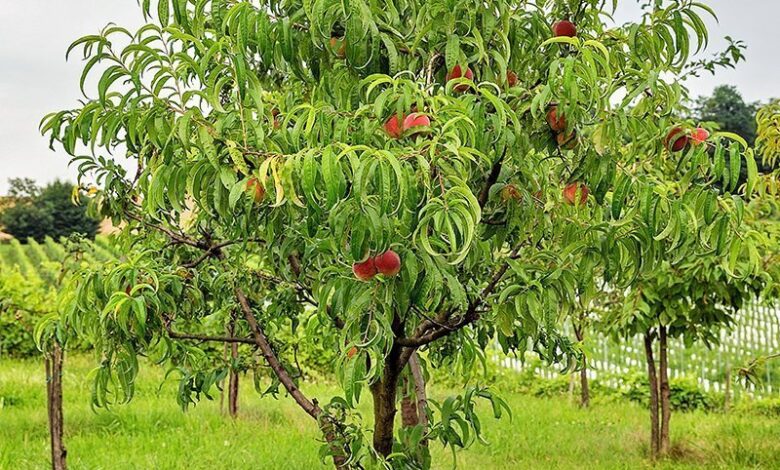Everything You Need to Know About Growing and Caring for a Peach Tree 2024

Introduction to Peach Tree
Peach trees are a delight in any garden, bringing a touch of beauty with their fragrant blossoms and rewarding gardeners with delicious, juicy fruit. Known for their sweet and tangy flavor, peaches are enjoyed fresh, canned, or in recipes. However, growing a peach tree involves a bit more than just planting and waiting. This guide will take you through every step to ensure your peach tree thrives and produces abundant fruit each season.
Whether you’re a seasoned gardener or just starting, learning how to care for a peach tree can be a rewarding journey. From selecting the right variety to dealing with pests, this comprehensive guide covers everything you’ll need to know to grow healthy, fruitful peach trees in your yard orchard.
History and Background of the Peach Tree
The peach tree has a fascinating history, originating in China over 4,000 years ago. It was prized not only for its delicious fruit but also as a symbol of longevity and immortality in Chinese culture. Ancient travelers and traders eventually spread peach trees westward along the Silk Road to Persia, where the fruit became known as the “Persian apple.”
By the time the fruit reached Europe, it was a luxury item and highly valued in royal courts. The peach tree arrived in the Americas through Spanish explorers in the 16th century. Over time, selective breeding developed various peach varieties, making them better suited to different climates and preferences.
Modern-day peach trees are bred to produce fruit in various colors, flavors, and textures. While some are ideal for cooler climates, others are bred for warmth, making peaches accessible to gardeners around the world. Despite centuries of cultivation, remain a beloved addition to home gardens.
- Choosing the Right Peach Tree Variety
Selecting the right peach tree variety for your garden is essential. While the choice can seem overwhelming, knowing your climate and specific needs will help you pick a tree that grows well in your area.
2.1 Clingstone vs. Freestone Peaches

Peach varieties are often divided into two main types: clingstone and freestone. The difference lies in how the flesh adheres to the pit.
- Clingstone Peaches: These are typically early-season peaches, and as the name suggests, the flesh “clings” to the pit. They’re juicy and flavorful, often used for canning and preserving.
- Freestone Peaches: Freestone varieties are easier to eat fresh since the flesh separates easily from the pit. These peaches are usually harvested later in the season and are ideal for fresh eating, baking, and cooking.
2.2 Types of Peach Trees by Climate Zone
are sensitive to frost, and choosing a variety suited to your climate zone is crucial. Low-chill varieties are best for warmer regions, while high-chill types thrive in cooler areas with more pronounced winters.
Some popular varieties include:
- Elberta: Known for its classic peach flavor, this freestone variety does well in zones 5-9.
- Redhaven: Another freestone, popular in colder zones, with excellent cold tolerance.
- Florida King: A low-chill variety suited to the warm regions of the South.
Choosing the right variety ensures your will bloom at the right time, avoiding frost damage and maximizing fruit production.
- Ideal Growing Conditions for Peach Trees
Creating the perfect environment for your is essential for its growth and productivity. Peaches need full sun, well-drained soil, and space to expand their roots.
3.1 Soil Requirements
Peach trees prefer slightly acidic, well-drained soil with a pH between 6.0 and 7.0. Sandy loam soils work well, as they provide good drainage while retaining enough moisture for the tree’s needs. Avoid clay-heavy soils, which can lead to root rot.
To test your soil, a simple pH test kit can help determine if adjustments are needed. Adding organic matter or sand to the soil can help with drainage and nutrient availability, promoting healthy root development and fruit production.
3.2 Sunlight Needs
Peach trees thrive in full sun, requiring at least 6-8 hours of direct sunlight daily. Without enough sunlight, may struggle to bloom and produce fruit. The sun also helps to dry moisture on leaves, reducing the risk of fungal diseases. For optimal growth, plant your in a location that offers plenty of light throughout the day.
- Planting a Peach Tree
Knowing when and how to plant a sets the stage for its successful growth. Timing, preparation, and planting techniques play key roles.
4.1 When to Plant a Peach Tree
The best time to plant a is during late winter or early spring when the tree is dormant. In warmer regions, fall planting is also an option, giving the roots a chance to establish before spring growth begins. Planting during dormancy helps avoid transplant shock and ensures the tree can focus on root establishment.
4.2 Step-by-Step Planting Instructions
- Dig the Hole: Make a hole twice the width and depth of the root ball to give roots space to spread.
- Position the Tree: Place the tree in the hole, ensuring that the graft line (if grafted) is just above soil level.
- Fill and Water: Refill the hole with soil, gently tamping down to eliminate air pockets. Water thoroughly to settle the soil around the roots.
- Mulch: Apply a 2-3 inch layer of mulch around the base, keeping it away from the trunk to prevent rot.
- Watering and Mulching for Health
Proper watering and mulching are critical for the health of a peach tree. Both techniques help maintain moisture levels and reduce weed competition.
5.1 Watering Guidelines

Newly planted need consistent moisture to establish roots. Water deeply once a week, adjusting depending on rainfall and soil type. Mature trees require less frequent watering but benefit from deep soaking during dry spells, particularly in hot summers.
5.2 Mulching for Moisture and Weed Control
Mulch helps to retain soil moisture, regulate temperature, and prevent weed growth. Use organic mulch like straw, wood chips, or compost, applying it in a 3-foot radius around the tree. Keep mulch at least a few inches away from the trunk to reduce the risk of diseases.
- Fertilizing Your Peach Tree
Fertilization provides essential nutrients for strong growth and fruit production. need specific nutrients to thrive, especially nitrogen, phosphorus, and potassium.
6.1 When and How to Fertilize
Start fertilizing young in their second year. Apply a balanced fertilizer in early spring, just before the growing season. Follow up with a second feeding in mid-summer to encourage continuous growth.
6.2 Nutrients Needed for Optimal Growth
benefit from fertilizers with a balanced N-P-K ratio, such as 10-10-10. For established trees, increasing the nitrogen content supports fruit production. Remember to water well after applying fertilizer to help nutrients reach the roots.
- Pruning Your Peach Tree
Regular pruning helps maintain an open canopy, which improves air circulation and sunlight exposure for healthier fruit development.
7.1 Why Pruning is Essential
Pruning keeps the tree’s shape manageable and prevents disease by promoting airflow. It also directs the tree’s energy toward fruit production rather than excessive foliage growth.
7.2 Best Pruning Techniques for Peaches
Peach trees benefit from an “open-center” pruning method. This technique removes the central leader and encourages the growth of three to five main branches, creating a vase shape. Prune in late winter while the tree is dormant to avoid exposing new growth to frost.



